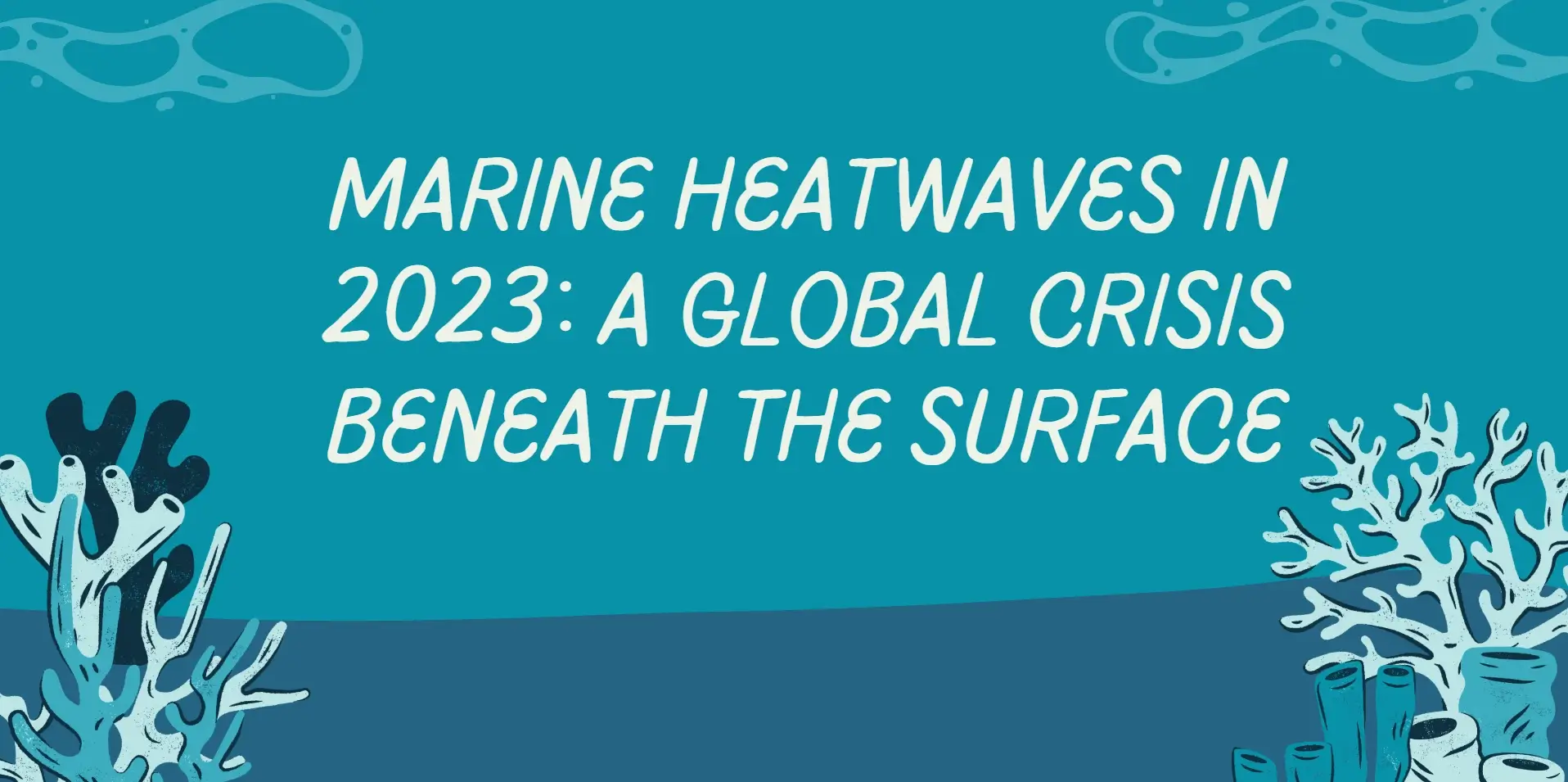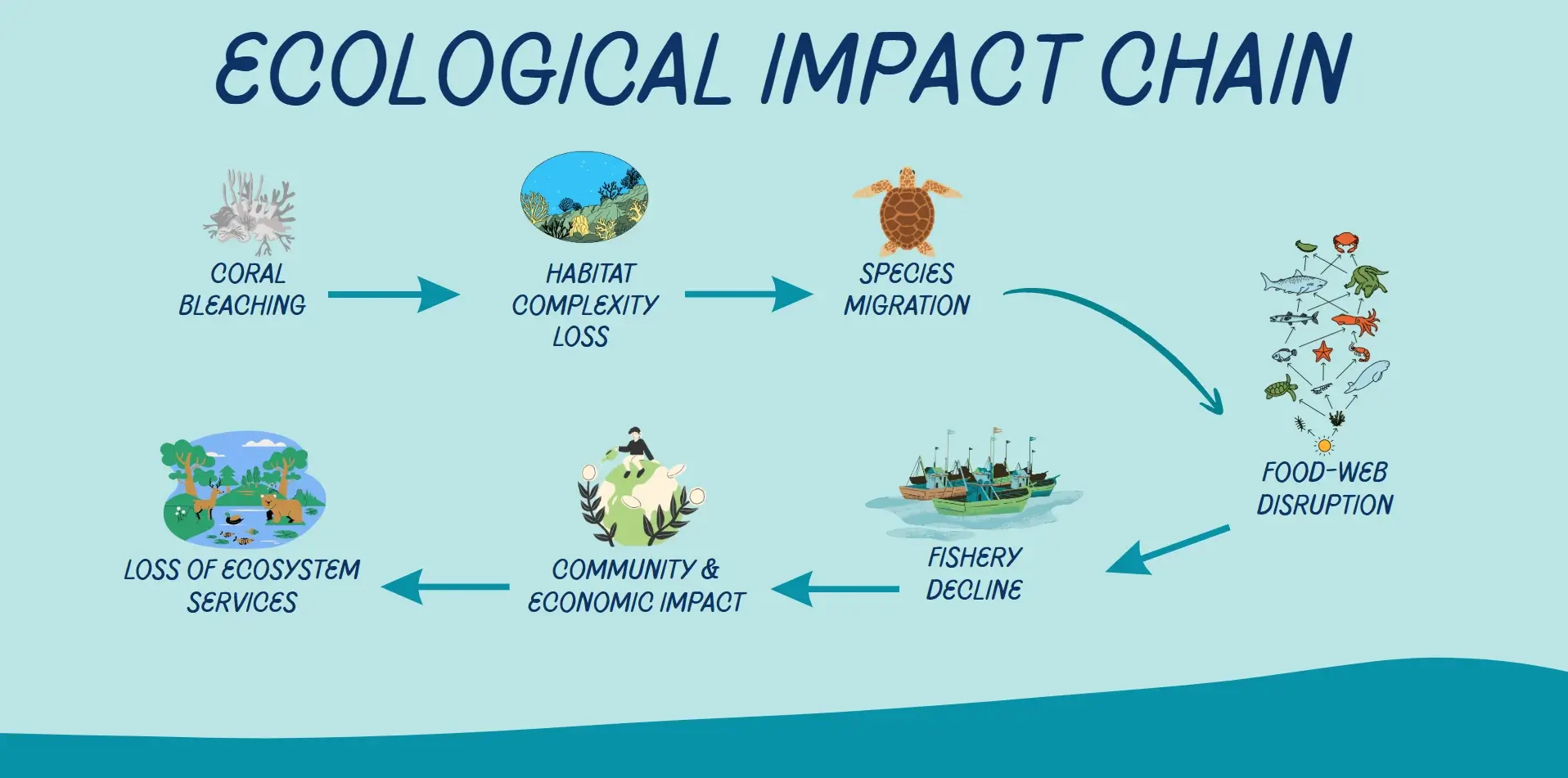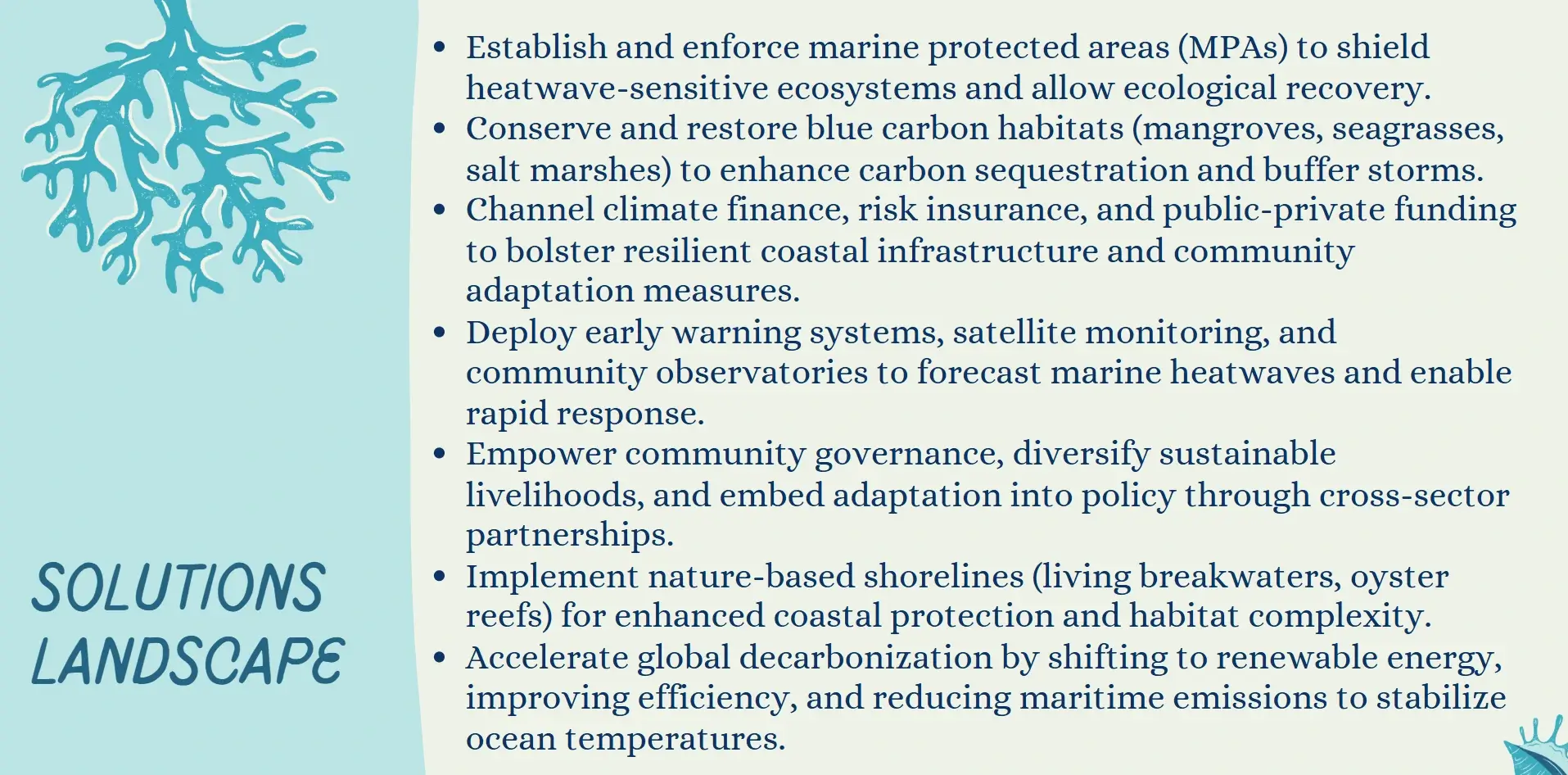In 2023, marine heatwaves were experienced even in most of the world oceans and took untypically long period and increasingly finding potential risks to the ecosystems, economy and coastal communities across the world.

The year 2023 was a turning point in the on-going climate catastrophe and marine heatwavesscorched almost all (95.9 percent) of the world ocean surface, which was to say the most to date that shocked oceanographers and policy professionals alike. These lengthy events which are four times atypical of previous times are not anomalies but are signs of a very fast changing planet exhibiting warming. Marine heatwaves are taking the form of rogue geophysical agents of planetary destabilization driven by increasing levels of El Nino, the rise in greenhouse gas concentrations and the reduction in oceanic resilience.Their effects are less noticeable yet equally harmful to organisms, compared to the earthly heat incidents: they cause coral bleaching, movement of species, the failure of food chains, and overall poor health of the ecology. Beyond the ecosystems, there is the economic and societal aftermath: fisheries and tourism in coastal communities decline, national and global economies are subjected to ripple effects and food security in the world faces the pressure of being strained at the end.In this article, we will expand on the scientific foundations of marine heatwaves, and present the eye-watering statistics of the year 2023, and untangle the spiral effects in the ecological, socioeconomic, and geopolitical levels. It contends that marine heatwaves should be acknowledged not only as environmental curiosities but as multi-systemic threats in need of immediate global concern, inter-nation collusion, and multi-vulnerability adaptation. The fever of the ocean is a warning to us and the response of our action will define our future in common.
Marine Heatwaves Science
Marine heatwaves (MHWs) are extended episodes of aberrantly hot oceanic temperatures, and they are being witnessed in the world waters. They are increasingly more frequent and intense as an indicator of the disturbing change in the ocean-climate interactions.
Definition and Dynamics
Marine heatwaves are temperature events in the oceans that are defined as a five-day or more temperature anomaly in the oceans in terms of sea surface temperature, with the temperature above the 90thpercentile of a historical baseline. Such phenomena may be extensive in the scale of areas, as may possibly be the scale of specific bays up to the scales of oceans, where they frequently go unobserved at the low levels below the surface requiring sophisticated surveillance tools. Although transient weather phenomena also cause SST fluctuation, MHWs are unique in that they are persistent and disruptive.
Climatic Drivers
Ocean Heatwaves are a combination of many variables. During the El Nino and Indian Ocean Dipole events the surface heating processes are aggravated due to the stagnant wind patterns and reduced mixing between various levels. Warming caused by greenhouse gases also increases thermal inertia in the oceans further limiting the capacity of oceans to act as a buffer against heat. The anthropogenic warming has greatly elevated the probability and intensity of MHWs since its rise in the 1980s, which is shown through models under CMIP6 scenarios.
Ecological Significance
MHWs cause chain reactions throughout the marine ecosystems notwithstanding the fact that they cannot be observed with naked eyes. There is coral bleaching, shifts of plankton and migration of fish and these interfere with the food web and biodiversity. All these alterations threaten ecosystem services fisheries, carbon sequestration, and so on. In contrast to land-based heatwaves, marine equivalents are imperceptible at the time of occurrence; however, their overall effects on the ocean health remain significant one as well.
What it matters?
Research about MHWs is instrumental not just in ocean science but also to the overall resilience of the world. The way in which they are related to climate change, ecological disintegration, and bringing social and economic systems out of balance, suggests taking a rapid multidisciplinaryapproach and reaching a balance between internationalpolicies and adaptive methodology of governance. The ocean is warming and the humanity should act before the equilibrium can be destroyed.
Reflections 2023: The Best Year on Record
Marine heatwaves in the year 2023 set new global records in the duration and intensity of elevated thermal stress experienced essentially across the global ocean. This weather event marked a troublesome ramping up of warming patterns in the ocean.
Unprecedented Coverage
Satellite remote sensing and ocean buoy data showed that 2023 witnessed about 96 percent of oceans in the world being under maritime-heat-wave conditions. The amount was unprecedented in historical records, as even traditionally strongholds such as the Southern Ocean reported anomalous temperatures. Areas like north pacific, Mediterranean Sea and tropical Atlantic experienced multi-month heat anomalies in severe consequences to biodiversity and productivity in the oceans.

Extended Duration
In 2023, marine heatwaves were about four times longer than long-term averages and up to 30 days or 60 days. This period has enabled penetration of the heat to more proficient levels, down to the benthic realms, and not just the surface ecosystems. The irrepressibility was contributed mainly by a set of climate drivers, an early onset El Nino, less oceanic upwelling, and high concentrations of greenhouse gases which introduced thermal lock on the surface waters.
Climatic Amplifiers
These atmospheric patterns of seasonally weakened trade wind and high pressure systems stagnated ocean circulation and added to the record states at the time. In conjunction with an unusually high level of solar radiations and reduced cloud cover in major parts of the globe, this aspect resulted in localisation of heat at the atmosphere, which worsened thermo stress. Such extremes are spelt out by scientific models within the CMIP6 system of predictions, which caution that, in case emissions are not curtailed, such extremities will become baseline norms.
Monitoring Implications
The 2023 marine heatwave reset the definition of the "severe" nature of marine heatwaves and challenged climate scientists and policymakers to evacuate risk levels, enhance early warning system, and re-conceptualize coastal resilience and oceans management. It was not only a hot year but a revolutionary one in terms of the way we view the vulnerability of the ocean.
Ripple Effects of Ecological Fallout on Marine Life
The destructive ecological effects of marine heatwaves, which occur as underwater wildfire and destabilize delicate environments, endanger biodiversity, and breakdown marine food webs with ecological knock-on effects to other interdependent ecosystems.
Coral Catastrophe
One of the first to be affected, due to thermal stress, includes the coral reefs that experience mass bleaching when the temperatures rise and stay so. The unprecedented bleaching that took place in 2023 in vast reef systems such as the one in the Indian Ocean, as well as the one in the Caribbean. The disappearance of coral symbiosis affects the health of the reefs by making them less complex and potentially killing the species which live on the coral formations. Ecosystem resilience is undermined because once it is damaged it may take decades before it can recover.

Broken Food Networks
When the temperature increases, marine creatures adapt by moving toward the poles or traveling down to lower levels of the waters to seek cooler environments. This geographical displacement interferes with predator-prey dynamics and changes innutrient turnover. To take another example, warming can result in plankton blooms that are more favourable to gelatinous species than to crustaceans, recasting higher-trophic level diets. The cascaded transition undermines the ecological soundness of fisheries and the endangered population of indigenous species.
The Endangered Fisheries
Those fish species that are commercially important, e.g., sardines, mackerel, and anchovies, are very susceptible to thermal stress. In 2023, recruitment was precipitously reduced in certain populations because of the change in the spawning conditions and the deterioration of the habitats. Not only do these fisher-crashes pose the risks of economic sustainability to fishing communities, but they also have a negative impact on the overall world supply of protein.
The Stressed Ecosystem Services
The essential carbon sequestering and shoreline protection sea-grasses, kelp forests, and mangroves are dying off when exposed to long periods of heat. When these blue carbon sinks degrade, they lose their capacity to offset climate change, which increases the risks of ocean acidification and erosion. Simply put, marine heatwaves undermine the natural defense mechanism nature has developed and this poses a grave danger to planetary balance on both, sea floor and the surface.
Socioeconomic Effects
Marine heatwaves are a socioeconomic flashpoint that can lead to ecological disasters, food insecurity, and the financial protection of livelihoods and businesses, in addition to environmental crises.
Livelihoods on the Threat Line
Areas along the Pacific coast in Southeast Asia through to the Atlantic coast in West Africa share this fate of coastal communities in countries and territories of these regions that are dependent on artisanal fisheries, losing a huge percentage of their income at a time when fish stocks are fleeing or collapsing due to thermal stress. Fewer catches and destroyed marine ecosystems interfere with local economies and compel neighbourhoods into insecure jobs or internal displacement. Fishing ports experienced dwindling as well as shrinking profits and decreasing landings in 2023, which worsened poverty levels and stressed the existing informal safety nets.
The disruption of tourism and Marine Economies
The industry of coastal tourism, particularly in tropical countries, was seriously affected, since coral bleaching reduced diving opportunities, algal blooms contaminated recreational waters and higher sea temperatures led to fish death. Marine heatwaves have entailed the subversion of seasonal revenues and diminished the interest of travellers across the world, including the effects felt by thousands of workers in the hospitality industry, transportation, and the marine sector, in Caribbean resorts to Southeast Asian archipelagos.
Threats to Food Security
The dwindling yield of fisheries threatens the availability of low-cost protein to millions of people living in low income countries that rely on fisheries. Limited availability was presented in 2023 to small pelagic species, which is essential as subsistence. Increasing prices and decreasing supply chains escalated nutritional inequality which compelled food shift that compromises health outcomes among vulnerable groups.
Wider Economic implications
Off the shores, the marine heatwaves destabilize the entire seafood trade, insurance pools (because of climate-related risks caused by the ecosystem) and infrastructure that is dependent on steady ocean waves. In 2023, selected nation economies showed contractions of their GDP associated with maritime degradations, underscoring enshrined vulnerability of maritime-reliant sectors. They are diffuse costs, yet hard to ignore anymore.
Geopolitical and Policy Implications
Marine heatwaves (MHWs) are no longer only an ecological disrupter but a geopolitical tension accelerator and governance predicament.
- With warming seas pushing fish stocks over national borders, the clash over rights to access resources in the seas has escalated, especially in lawless seas like the South China Sea, West Africa, and the Arctic.
- The cross-border character of MHW induced migrations compromises current fisheries facilities and instructs the adoption of new adaptive and climate-responsive models.
- Ocean-based economies are also endangered by rising sea temperatures and this puts a strain as to how they work together concerning blues carbon trading, marine protected areas, and sustainable development goals.
- Countries that have developed ocean surveillance and almost early-warning networks can better absorb any impacts, which widen the digital and adaptive divide between the Global North and the South.
- Such an imbalance poses a threat to leaving vulnerable states on the bargaining table behind.
- International legal instruments such as UNCLOS and frameworks under UNFCCC need to be revised to ensure marine heatwaves resilience in form of strengthened climate-finance tools, ocean-observation systems and enforceable mitigation goals.
- The above extreme conditions in 2023 indicate that multi-scalar ocean governance is immediately needed a combination of local understanding, science, and regional diplomacy.
- As marine heatwaves may turn into global hotspots, unless addressed in a coordinated way, they are likely to undermine both ecological stability and geopolitical trust.
Solutions and Way Forward
The increasing menace of the marine heatwave needs cross-sectoral measures encompassing scientific ingenuity, policy reconstitution, and community action.
- The most important of them are advanced early-warning systems based on satellite data and predictive models of the oceanography conditions, which enable governments and coastal interests to anticipate adaptive response before ecological tipping points are breached.
- By increasing marine protected areas (MPA), vulnerable ecosystems will be cushioned, and biodiversity promoted to recover.
- Restoration programmes such as coral gardening, kelp reforestation and mangrove rehabilitation, adds resilience to the ocean and increases carbon removal.
- Blue carbon investment is an action that provides climate and economic solutions, especially to countries with long coastal lines.
- In policy domain, the policies of adaptation to climate change should include the indicators of heat stress in the oceans.
- There should be legal changes in line with UNCLOS, regional fisheries agreements provisions in terms of recent changes in stock boundaries and commonality in governance.
- The financing of climate actions should also focus on solutions that revolve around the sea, where low-income countries along the seaside face massive impacts of ocean warming should be assisted in capacity building.
- Educational and public awareness were also necessary to foster stewardship and changes in behaviour. Resilience is increased at the local level using citizen science and sustainable livelihoods programs involving local communities.
- It is a coordinated international effort that is needed to protect the ocean health at last, and not perceive marine heatwaves as a kind of exception, but as a problematic systemic trend related to the future of our planet as a whole.

Conclusion
The marine heatwaves of 2023 were not a unique event and should not be seen as such. It was the alarm of a new climate normal in the oceans, and the results can be disastrous. 96 percent of the world's oceans are already impacted, and the time-frames surpassing the past averages by far, such thermal extremes are putting the whole ecological balance in jeopardy, destroying the very livelihoods incoastal areas, as well as creating burdens on the global economy and geopolitical systems. The ocean, which can be described as a counterweight to the effects of climate variability, is currently sounding alarm calls by increasing temperatures, biodiversity destruction, and changes in currents.This article has followed the science, effects,and global consequences of marine heatwaves, which demonstrates their significance well beyond the environmental communities. With oceans heating up, our policies, technologies, and our determination are also being brought to recalibrated of angles. The action has to be urgent, collaborative, and cross-cuttingbased on scientific foresight and socio-political determination. Since the underlying fact in the warming waters is that the future of the seas determines the future of us.